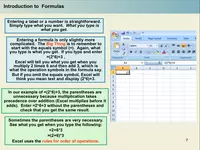Spreadsheet Warm Up for SSAC Geology of National Parks Modules
Summary
This Spreadsheets Across the Curriculum module introduces students to the electronic spreadsheet as a tool for elementary calculation. The module covers some basics, including the components of a spreadsheet, the necessity of an equals symbol for cell formulas, how the mathematical concept of function applies to spreadsheets, and a few mechanical things such as copying and pasting. It also covers some basic quantitative-literacy material that will come up in later modules -- order of operation, unit conversions using proportions, order of magnitude, and a few elementary functions. The module is basically a tutorial followed by a hefty end-of-module assignment that elaborates on the QL concepts introduced in the tutorial. The data used in the spreadsheets are areas and numbers of visitors for 25 parks (10 in the tutorial, 15 in one of the end-of-module problems).
This material is based upon work supported by the National Science Foundation under Grant Number NSF DUE-0836566. Any opinions, findings, and conclusions or recommendations expressed in this material are those of the author(s) and do not necessarily reflect the views of the National Science Foundation.
Learning Goals

Students will:
- Read an introductory slide pointing out that a course like Geology of National Parks requires some quantitative literacy and that spreadsheets provide an easy and convenient way to work with numbers.
- Read a series of slides introducing the components of a spreadsheet such as cell addresses, the formula bar, and how to enter formulas.
- Create cell formulas to explore what numbers are produced when one combines three numbers in various ways with symbols for addition, subtraction, multiplication, division, and exponentiation.
- Study a pair of slides that build a spreadsheet that lists the areas of ten selected national parks in acres and converts the areas to square miles.
- Study a slide that introduces the common logarithm as the built-in function producing the order of magnitude of a number and uses it in a spreadsheet to determine the order of magnitude of the number of annual visitors to each of the ten selected parks./li>
- Study a pair of slides using built-in functions in a spreadsheet to find the total, maximum, minimum and average number of visitors to the ten parks.
- For the end-of-module assignment: summarize their findings on the rules for order of operations; convert distances from miles to kilometers, then to proportion of the Earth's radius; use the common logarithm function to construct a logarithmic scale plotting familiar astronomical distances; craft a definition for the common logarithm function using the word exponent; and download a spreadsheet of 15 parks with their areas and numbers of visitors and then find the parks with the most and fewest visitors per square mile.
In the process, the students will:
- Recall or relearn some basic concepts including order of operations, order of magnitude, proportions and unit conversions, and the definition of a function.
- Get started with working with numbers in a spreadsheet
- Learn that numbers and some elementary mathematics will be part of the course and that they will use spreadsheets to work with the numbers and do the math.
Context for Use
This module is designed for potential use in the Geology of National Parks service course at USF. The course is offered as an online course every semester. It includes readings from Parks and Plates, weekly quizzes based on that textbook, and weekly student activities designed to align the course with the University's general education requirements. This module is intended to be one of those activities, with the specific goal of meeting the gen-ed quantitative literacy dimension.
Description and Teaching Materials
The module is a PowerPoint presentation with embedded spreadsheets. Click on the link below to download a copy of the module.
- PowerPointSSACgnp.QA76.75.DKM1.2 (PowerPoint 3MB Jun1 13)
Optimal results are achieved with Microsoft Office 2007 or later; the module will function in earlier versions with slight cosmetic compromises. If the embedded spreadsheets are not visible, save the PowerPoint file to disk and open it from there.
The above PowerPoint presentation file is the student version of the module. It includes a template for students to use to complete the spreadsheet(s) and answer the end-of-module questions, and then turn in for grading.
An instructor version is available by request. The instructor version includes the completed spreadsheet. Send your request to Len Vacher (vacher@usf.edu) by filling out and submitting the Instructor Module Request Form.
Teaching Notes and Tips
The module is constructed to be a stand-alone resource. It can be used as a homework assignment, lab activity, or as the basis of an interactive classroom activity. It was used as an out-of-class activity in a senior-elective course, Environmental Geology of the National Parks (for geology majors and nonmajors), during development of the module in Spring 2010, and as an out-of-class activity in Computational Geology (a QL course for geology majors) in Fall 2010 and Fall 2011. It has not been implemented yet in the introductory-level Geology of National Parks course.
Assessment
There is a slide at the end of the presentation that contains end-of-module questions. The end-of-module questions can be used to examine student understanding and learning gains from the module. Pre/post test, pre/post test answer key, and answer key for end-of-module questions are at the end of the instructor version of the module.
The idea for this module arose from the experience in earlier semesters that many students were dismayed by the sight of math and flummoxed by the need for a spreadsheet in the module that was used as one of the weekly activities. We will implement this module in the same semester that we add more modules from this collection. We hypothesize that our pre- and post-implementation data will show that the combination of more modules and presence of a starting tutorial module will associate with a more-positive student attitude about the presence of elementary math in an introductory geology course.




